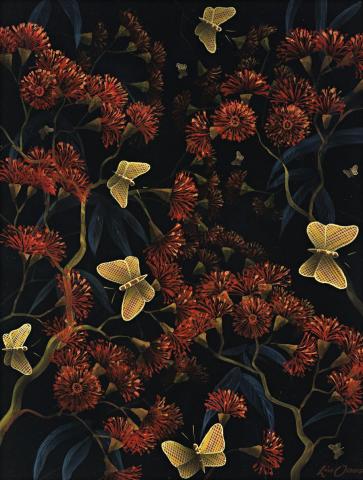BUTTERFLIES, SHERBROOKE FOREST, c.1994
LIN ONUS
synthetic polymer paint on compressed card
50.0 x 38.0 cm
signed lower right: Lin Onus
Gallery Gabrielle Pizzi, Melbourne
Private collection, Perth
'I kind of hope ... that history may see me as some sort of bridge ... between ... cultures, between technology and ideas.'1
Born in 1948 of Yorta Yorta and Scottish descent, Lin Onus remains acclaimed today as a 'man ahead of his time', exploring through his art the personal, public and political fundamentals of reconciliation. Straddling dualistic perspectives - one Western and representational, the other Aboriginal and spiritual - Onus thus enjoyed the freedom to absorb a diverse range of influences, subverting Western perceptions of indigenous art with subtlety and sophistication. Indeed, occupying what anthropologist Levi Strauss defines as that 'in-between' space between multiple worlds, Onus was afforded the rare opportunity 'to glimpse through many slightly ajar doors' - paradoxically belonging everywhere, and nowhere. As Margo Neale elaborates in the catalogue accompanying the artist's retrospective at Queensland Art Gallery in 2000, 'his works are like the tales of a roving storyteller or mythmaker.'2
Inheriting the revolutionary spirit of his father, Bill Onus, who was the founder of the Aboriginal Advancement League in Victoria and a prominent creator of Aboriginal-inspired tourist artefacts near Upwey, it was inevitable that during his early years Onus too would become a strident activist in the political debate on issues of native title and equal opportunity. Perhaps most renowned was Onus's protest in 1971 in the Dandenong Ranges, specifically the Sherbrooke Forest - a lush rainforest landscape, rich in fern-filled gullies and native fauna, from which the present work derives its inspiration. Staged in the wake of the Victorian Government's Aboriginal Lands Act 1970 which returned land to Aboriginal communities at Framlingham and Lake Tyers, the protest involved Onus camping in the forest for three months and vowing to remain there until the Aboriginal claim to the land was recognised. Although the demonstration ended prematurely, the incident not only succeeded in highlighting the issue of land rights to a wider audience but, importantly, served as the impetus for Onus's painting career - with the ever non-confrontational figure realising that he could communicate his messages more powerfully through the medium of art.
Arguably most influential upon Onus's artistic evolution however, was the relationship he fostered in Arnhem Land with the highly esteemed Aboriginal painter who became his adoptive father and mentor, Jack Wunuwun. Inspired by the older artist's bark painting techniques such as rarrk (cross-hatched designs), Onus subsequently embraced a truly unique style of landscape painting which, rich in reflections and ambiguities, substituted the traditional European panoramic view for one described by his mentor Wunuwun as 'seeing below the surface.' Evocative of Wunuwun, thus the present Butterflies, Sherbrooke Forest, c.1994 features the 'Aboriginalising' of native fauna with the butterflies unmistakably rendered in the colours and techniques of Aboriginal painting. In the same vein as his monumental landscape, Bunpa near Malwan, 1992 populated with similarly adorned butterflies, and more explicitly, Hovering til the Rains Come, 1995 where stingrays are literally 'out of water' traveling across the land in search of waterholes, Onus here suggests an iconography of displacement, with the Aboriginal markings on the butterflies offering just enough ambivalence to disrupt any simple reception of the painting based upon its otherwise 'realist' representation. Both mesmerisingly beautiful and multifaceted in its meaning, indeed the work illustrates well Onus's desire to create an art that could be appreciated on numerous levels by everyone; as Neale suggests, elucidating the deeper significance of such works, '... they are deceptively picturesque, for things are not always what they seem. Laden with crosscultural references, visual deceits, totemic relationships and a sense of displacement, they, amongst other things, challenge one's viewing position.'3
1. Lin Onus, artist statement, 1990 cited in Neale, M., Urban Dingo: The Art of Lin Onus 1948-1996, Queensland Art Gallery, Brisbane, 2000
2. ibid., p. 18
3. Neale, M., Lin Onus, exhibition catalogue, Savill Galleries, Melbourne, 2003, p. 1
VERONICA ANGELATOS
